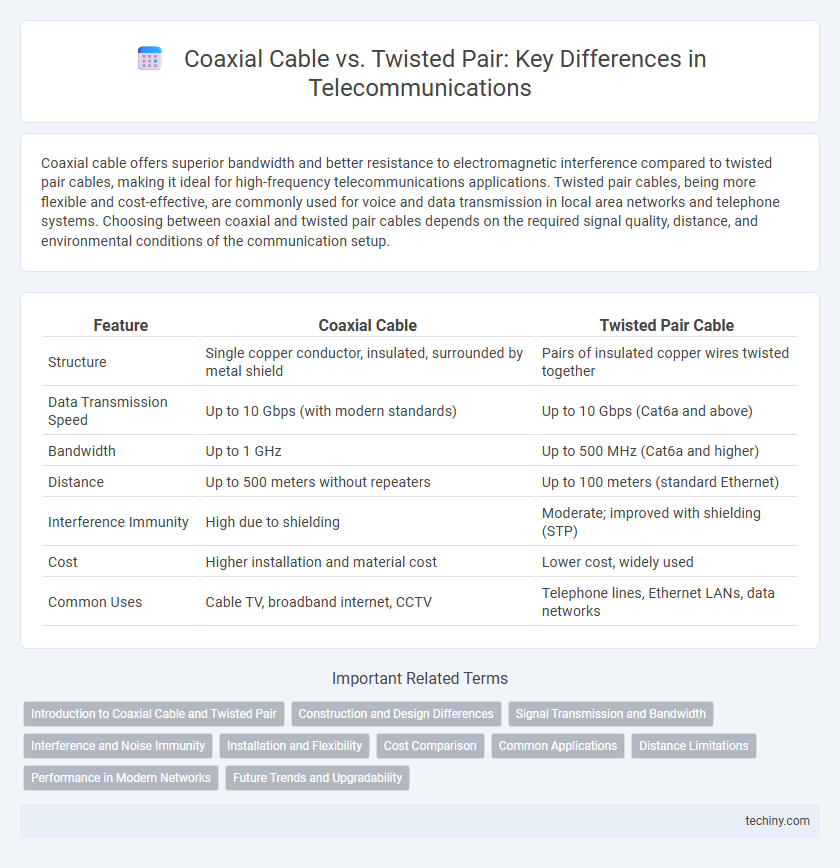Coaxial cable offers superior bandwidth and better resistance to electromagnetic interference compared to twisted pair cables, making it ideal for high-frequency telecommunications applications. Twisted pair cables, being more flexible and cost-effective, are commonly used for voice and data transmission in local area networks and telephone systems. Choosing between coaxial and twisted pair cables depends on the required signal quality, distance, and environmental conditions of the communication setup.
Table of Comparison
| Feature | Coaxial Cable | Twisted Pair Cable |
|---|---|---|
| Structure | Single copper conductor, insulated, surrounded by metal shield | Pairs of insulated copper wires twisted together |
| Data Transmission Speed | Up to 10 Gbps (with modern standards) | Up to 10 Gbps (Cat6a and above) |
| Bandwidth | Up to 1 GHz | Up to 500 MHz (Cat6a and higher) |
| Distance | Up to 500 meters without repeaters | Up to 100 meters (standard Ethernet) |
| Interference Immunity | High due to shielding | Moderate; improved with shielding (STP) |
| Cost | Higher installation and material cost | Lower cost, widely used |
| Common Uses | Cable TV, broadband internet, CCTV | Telephone lines, Ethernet LANs, data networks |
Introduction to Coaxial Cable and Twisted Pair
Coaxial cable consists of a central conductor surrounded by an insulating layer and a metallic shield, offering high resistance to electromagnetic interference and enabling higher bandwidth transmission over longer distances. Twisted pair cable comprises pairs of insulated copper wires twisted together to reduce crosstalk and electromagnetic interference, making it widely used for telephone and Ethernet networks. Both cable types serve crucial roles in telecommunications infrastructure, with coaxial cables preferable for cable TV and broadband, while twisted pair cables dominate in local area networking.
Construction and Design Differences
Coaxial cables feature a central copper conductor surrounded by a dielectric insulator, a metallic shield, and an outer plastic jacket, providing robust protection against electromagnetic interference. Twisted pair cables consist of pairs of insulated copper wires twisted together to reduce crosstalk and electromagnetic noise, often enclosed in a protective sheath. The distinct construction of coaxial cables enables higher bandwidth and longer transmission distances compared to the more flexible and cost-effective twisted pair cables used in local area networks.
Signal Transmission and Bandwidth
Coaxial cable provides higher bandwidth and better resistance to electromagnetic interference compared to twisted pair cables, making it ideal for long-distance and high-frequency signal transmission. Twisted pair cables, especially unshielded twisted pairs (UTP), are more susceptible to signal degradation but offer cost-effective solutions for short-range, lower bandwidth applications such as local area networks. The shielding and construction of coaxial cables enable more stable data transfer rates and reduced signal loss over extended distances.
Interference and Noise Immunity
Coaxial cables exhibit superior interference resistance and noise immunity due to their single copper conductor enclosed by a shielded metallic layer, effectively minimizing electromagnetic interference (EMI). Twisted pair cables, while more susceptible to EMI, improve noise resistance through the twisting of pairs, which reduces crosstalk and external interference. In high-noise environments, coaxial cables outperform twisted pair cables in maintaining signal integrity and minimizing data loss.
Installation and Flexibility
Coaxial cable installation requires precise connectors and rigid handling due to its shielding and thickness, making it less flexible in confined or complex routing environments. Twisted pair cables, with their lighter construction and greater bend radius, offer easier installation in tight spaces and adaptable routing through walls and conduits. This flexibility reduces labor time and costs in telecommunications setups while supporting diverse network layouts.
Cost Comparison
Coaxial cables typically incur higher initial installation costs compared to twisted pair cables due to their complex shielding and thicker materials. Twisted pair cables, especially unshielded variants, offer a more budget-friendly solution for short to medium distances with adequate performance. Maintenance and repair expenses for twisted pair cables tend to be lower, making them the preferred choice for cost-sensitive telecommunications projects.
Common Applications
Coaxial cables are commonly used in cable television distribution, internet connections, and video surveillance systems due to their high bandwidth and resistance to electromagnetic interference. Twisted pair cables are prevalent in local area networks (LANs), telephone lines, and Ethernet connections, offering cost-effective installation and flexibility for short to medium distances. Both cable types serve distinct roles in telecommunications infrastructure based on their performance characteristics and application requirements.
Distance Limitations
Coaxial cables typically support longer transmission distances up to 500 meters without significant signal degradation, while twisted pair cables are generally limited to about 100 meters for balanced copper lines under Ethernet standards. The superior shielding in coaxial cables reduces electromagnetic interference, allowing reliable high-frequency signal transmission over extended ranges. In contrast, twisted pair cables require signal boosters or repeaters beyond their distance threshold to maintain data integrity in telecommunications networks.
Performance in Modern Networks
Coaxial cables offer higher bandwidth and better immunity to electromagnetic interference compared to twisted pair cables, making them suitable for high-speed internet and broadband applications. Twisted pair cables, particularly Unshielded Twisted Pair (UTP), remain widely used in Ethernet networks due to cost-effectiveness and ease of installation despite lower maximum data rates and shorter transmission distances. Modern networks often favor twisted pair cables for local area networking while coaxial cables support cable TV and high-frequency data transmission requiring greater signal integrity.
Future Trends and Upgradability
Coaxial cables, traditionally favored for their high bandwidth and shielding against electromagnetic interference, are increasingly challenged by the rise of twisted pair cables enhanced with advancements like Category 6A and Category 8 standards, which offer improved data transmission rates and reduced latency for future telecommunications infrastructure. Upgradability considerations prioritize twisted pair cables due to their compatibility with Power over Ethernet (PoE) technology and easier integration into evolving network topologies, supporting progressive deployment of 5G, IoT, and smart city applications. The trend towards fiber-optic convergence further pressures coaxial use, as twisted pair solutions evolve to bridge legacy systems with next-generation fiber networks, ensuring scalable, cost-effective upgrades in telecommunications.
Coaxial Cable vs Twisted Pair Infographic

 techiny.com
techiny.com